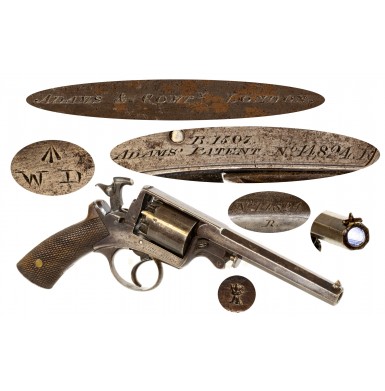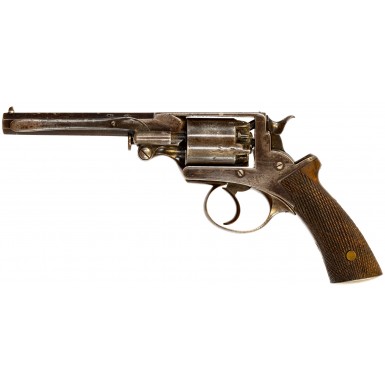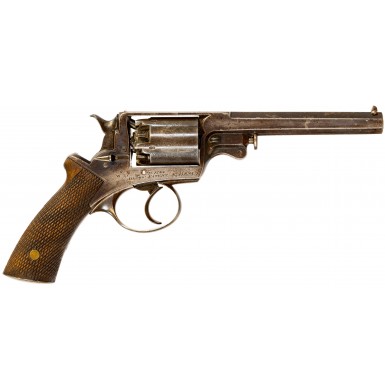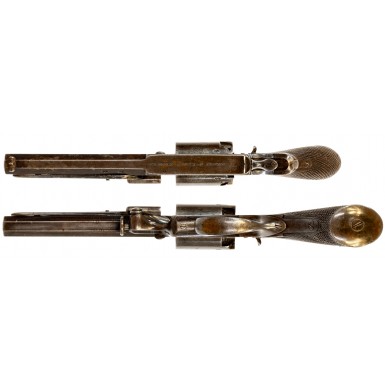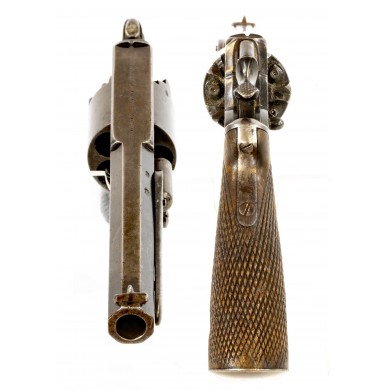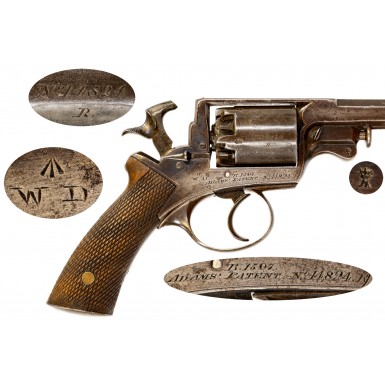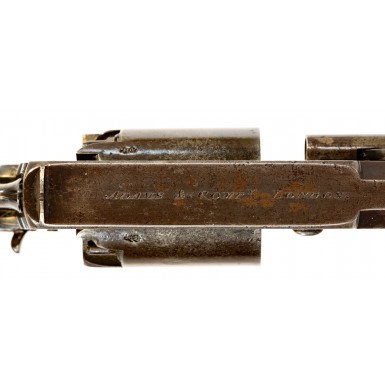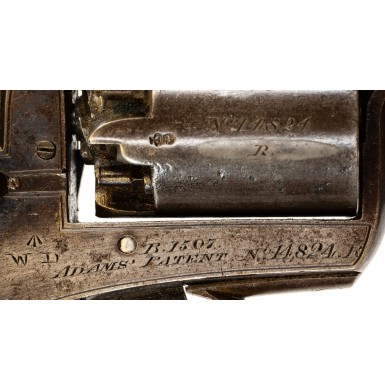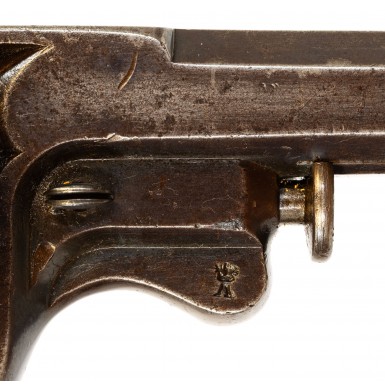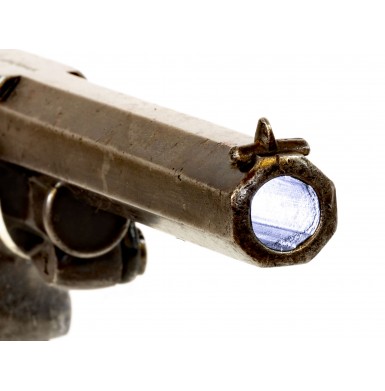Very Rare British Military Marked Model 1854 Beaumont-Adams Revolver
- Product Code: FHG-3501
- Availability: Out Of Stock
-
$2,795.00
This is a very scarce example of a British Military Marked Beaumont-Adams Model 1854 Percussion Revolver. While Adams revolvers in and of themselves are not particularly scarce, those that were acquired by the British War Department are actually quite rare. This is for a number of reasons. First, the leadership and bureaucracy of the British military, like that of so many military organizations around the world during the mid-19th century, was rather conservative. The British Board of Ordnance, reorganized under the umbrella of the War Department during 1854-1855, had always considered the handgun to be a weapon of limited issue to specialty troops only. In fact, other than cavalry regiments that were authorized to carry pistols, very few other British troops had that right. Within the infantry, it was only the sergeant major among the enlisted soldiers who was so authorized. While officers were authorized to carry handguns, they were typically supplied by the officer himself, at his own expense, with only the requirement that that the gun be chambered for a “service caliber”. Otherwise, the type of handgun (or handguns) that the officer acquired was only constrained by his personal preferences and his budget. Beyond the fact that handguns were not widely issued by the British military, the conservative leadership of the War Department considered the new-fangled revolvers to be unreliable when compared to traditional single shot, muzzleloading pistols. This same opinion apparently pervaded the officer corps at the beginning of the Crimean War as well, as more officers embarked for combat with single or multi-barrel muzzleloading pistols rather than percussion revolvers. Interestingly the lack of faith in the revolver remained with the British officer corps into the 1870s and early 1880s, when the numbers of breechloading double barrel “Howdah” pistols and two- and four-barrel Lancaster breechloading that were purchased for use by officers is considered.
The first revolvers to be acquired by the British Board of Ordnance (soon to be the War Department) were Colt Model 1851 “Navy” revolvers that were purchased from Colt’s London manufactory. The purchases began in March of 1854 and continued through February of 1856. In all a total of 23,700 were acquired. Of those guns 9,600 were issued to the Royal Navy, 5,000 were sent to the Army in the Crimea and 9,000 were sent into storage at the Tower of London for issue should the need arise. The missing 100 guns from the above dispositions appear to have been issued to civilian “Dockyard Police”. Considering the Anglo-centric bend of the British military during the period, it seems somewhat odd that the first revolvers to be purchased were American, even if they were produced in a London based factory. These Colts would remain in service for a couple of decades, in particular with the Royal Navy, until eventually replaced by breechloading metallic cartridge guns. Those guns that were sent to the Crimea for the Army were only issued to infantry officers in combat situations and the regimental sergeant majors in the infantry. For the mounted services, the revolvers were only issued as emergency arms due to the lack of available single shot muzzleloading pistols. That limited the issue of the new revolvers to the Lancers who were all authorized to carry handguns, as well as to Dragoon and Hussar sergeant majors and trumpeters. In general, the small caliber of the Colt revolver, at only .36 versus the massive .577 Lancer pistol, rendered the revolver an ineffective handgun in the minds of the War Department.
Following the initial acquisition of the Colt revolvers, some English-made guns were also purchased. On 31 August 1855 an order was placed for 300 “Revolvers, Dean (sic) & Adams Improved on Beaumont’s principle”. These guns were large caliber 38-Bore (nominally .50 caliber) handguns based upon Adams’ 1854 Patent and with the Beaumont improved lock work that provided operation that we would call a “traditional double action” today. The next order was placed on 3 January 1856 for 2,000 “Pistols, revolving, Dean (sic) & Adams’ patent, with Lieutenant Beaumont’s improvement, 54 gauge.” As was clear from this order, the second group of handguns was chambered for the more common 54-Bore (.442 caliber). During the early days of revolver acquisition 4,813 of these double action 54-Bore Beaumont-Adams revolvers would be delivered between 31 May 1856 and 31 March 1858. In the end a total of 7,236 Adams percussion revolvers of all types (both Model 1851 and Model 1854 pistols) would be acquired by the British military. Many of these guns were subsequently issued to the Royal Navy as well, while the larger bore .50 caliber revolvers saw some trial use with the 7thand 15th Hussars and the 3rd Light Dragoons. A look at the number of revolvers of all types in storage after the conclusion of the Crimean War, between 1858 and 1862, certainly indicates that the British military was not prioritizing the issue of these handguns. As of the beginning of 1858 a total of 30,906 revolvers of all types had been acquired. In February of 1858 some 15,764 were in storage, with even more the following year, some 18,157. In January 1861 a total of 14,481 were in storage and the following January 14,576 were in storage. As can be seen roughly half of the handguns owned by the military were not in service during this period. Conversely during the same period of time some 27,465 single shot muzzleloading pistols were acquired by the military with only 8,912 in storage in January of 1861 and 8,233 in storage the following January. Clearly the preference for the single shot pistols is clearly indicated by these numbers. Interestingly, while the Colt percussion revolvers would eventually be sold out of service after the adoption of breechloading metallic cartridge revolvers, many of the Model 1854 Beaumont-Adams revolvers were later altered to metallic cartridge and saw more service in that configuration than they ever did as percussion handguns. The end result is that percussion British military marked Adams revolvers are rarely encountered in their original and unaltered configuration.
The high quality, solid frame Adams patent revolvers were as important to the history and development of the revolving handgun as were the developments and designs of Samuel Colt. Robert Adams received his patent for a solid frame, one-piece revolver design in 1851. The patent covered his design for a very strong revolver, where the frame and barrel were machined from a single forging. Adams additionally patented a “self-cocking” lockwork, which today would be referred to as “double action only”. This mechanism cocked the spurless hammer, rotated the cylinder and released the hammer, all as the result of a single pull of the trigger. While this allowed for rapid firing of the gun, the long, heavy trigger pull inhibited accurate shooting. The solid frame and barrel and the “self-cocking” lockwork were incorporated into Adams’ Model 1851 series of revolvers. In 1854, Lt. Frederick Beaumont developed an improvement for Adams’ lockwork, which produced what would be called a traditional “double action” revolver today. The new lockwork allowed the revolver to operate in the fashion of Adams’ original design, but also added the facility to cock the revolver manually and fire it with a lighter “single action” trigger pull. In order to thumb-cock the action, a spur was added to Adams’ previously spurless hammer. This refinement allowed for more accurate shooting. In 1854 Adams also patented refinements to his original frame design by adding a sliding frame-mounted safety on the right side of the revolver, and an improved cylinder arbor retaining mechanism as well. The resultant combination of design improvements was manufactured as the Model 1854 revolver, known to most as the Beaumont-Adams revolver.
From the beginning of the production of the Beaumont-Adams revolvers, a second serial number was added to the frames with a “B” prefix to track the royalties due to Lt. Beaumont. This number would continue to appear on Adams patent revolvers through the middle of 1862, when Beaumont’s patent protection expired. The new revolvers were produced directly by Adams as part of his partnership with the London based Deane, Adams & Deane, as well under license by Birmingham makers like Joseph Brazier and Isaac Hollis & Sons. These makers can be identified by the use of a suffix after the serial number, a “B” in the case of Brazier and a “Y” in the case of Hollis & Sons. Adams also allocated specific serial number blocks to his licensees, making the use of serial numbers for the purposes of dating Adams revolvers quite difficult. These serial number blocks also suggest huge production quantities of Adams revolvers, when in fact some of the licensees only produced a few hundred guns, even though they were allocated a block of as many as 10,000 numbers. Adams himself used an “R” suffix for the guns that he produced, and very often, when Adams revolver serial numbers are discussed, it is assumed that the guns bear Robert Adams “R” suffix. Adams revolvers were also licensed for production in America (by the Massachusetts Arms Company), as well as in Belgium, and some of the Germanic states. William Tranter also employed Adams solid frame in the production of his own line of self-cocking revolvers. Upon the dissolution of the Deane, Adams & Deane firm, Adams went to work for the London Armoury Company, and his revolvers were produced there as well from approximately 1857-1859.
This British Military Marked Model 1854 Beaumont-Adams Revolver is in about VERY GOOD condition. The gun is a 54 bore (.442 caliber) revolver with a 5-shot cylinder and a 5 ¾” octagonal barrel. The obverse frame is engraved in two lines, below the cylinder:
B1507
ADAMS’ PATENT. No 14,824R
The cylinder is engraved with the matching serial number 14,824 over R. The most important marking is engraved to the rear of the frame marking, a British military {Broad Arrow} over the letters WD. The Broad Arrow was a long-time indicator of British military ownership and the letters “WD” stood for “War Department.” The “R” suffix after the serial number indicates that the gun was produced by Robert Adams and the “B” prefix indicates that the number following it is the Beaumont patent tracking number. This gun was number 1,507 to be produced with the Beaumont lockwork. The topstrap of the gun is engraved with a seldom encountered retailer mark that reads:
ADAMS & COMPY LONDON
This mark only appears on guns produced during part of 1856 as Adams was trying to fulfill his obligations and orders as the Deane, Adams & Deane partnership was dissolving and prior to his full-time employment at the London Armoury Company. The gun itself may have been produced slightly earlier than mid-1856, possibly the prior year, but based upon the markings was clearly delivered to the British War Department and almost certainly as part of the 2,000-gun order from January of 1856. The only other readily visible exterior markings on the gun are a British military inspection mark of a {CROWN}/A on the obverse of the lower frame lug, below the arbor pin and the typical London commercial proof marks on the upper left flat of the barrel and between the chambers of the cylinder. The matching assembly number 6386appears inside the triggerguard, on the rear face of the cylinder and on the reverse of the Kerr’s patent loading lever. Like most revolvers produced by Adams after the granting of his 1854 patents, the barrel is rifled with three wide grooves that are roughly twice the width of the three narrow lands.
As previously noted, the gun is in about VERY GOOD overall condition. It retains about 20%+ of its original blued finish. The finish remains primarily in protected areas like the rear of the frame, behind the cylinder on the lower flats of the barrel and on the barrel behind the loading lever. The finish loss appears to be quite organic, the result of natural thinning and wear from hoster carry and real-world use. The balance of the gun has a somewhat mixed and mottled plum brown and gray patina. The metal is mostly smooth with some scattered surface oxidation and minor roughness here and there, as well as some light pitting that is mostly noticeable on the barrel and frame immediately in front of the cylinder chambers and along the edges of the topstrap. These are all areas where the casutic gasses from firing the gun would cause erosion. The rear of the cylinder shows similar erosive wear in the percussion cone (nipple) recesses. There is a patch of oval discoloration around the “R” on the cylinder that looks like wear but is really staining, likely from the gun resting on that part of the cylinder for some time on a fabric surface that might have been moist. All of the cones (nipples) are all present, of the period and are in very nice, crisp, and completely usable condition with no heavy wear or battering. The gun retains its original Kerr’s patent loading lever. The lever is unmarked on the obverse and bears only the assembly number 6386 on its reverse, matching the other assembly numbered parts on the gun. The lever is fully functional, operating smoothly and locking securely into place when not in use. The action of the revolver needs attention, which is not uncommon. While the gun typically functions in single action mode with no real issues, the double action mechanism needs work. The hammer does not reliably lift when the trigger is pulled, and the cylinder feels as if it is locked up until the hammer is thumb cocked. This suggests that the ratch on the rear face of the cylinder is worn, making the hand too short to reliably rotate the cylinder. While the gun functions well enough to demonstrate, it is not reliable and certainly not functional from a shooting perspective. The original 1854 patent sliding safety is present on the right side of the frame and functions exactly as it should. It retains some of its original fire blued finish with some fading, dulling and loss. The original 1854 patent cylinder arbor retaining wing nut is in place on the right side of the frame and functions correctly as well. This delicate piece is often broken or missing, so it is nice to find it in complete, functional condition. The bore of the gun is also in about VERY GOOD condition. It is mostly bright with moderate frosting, strong rifling, and lightly scattered pitting along its length. The checkered one-piece walnut grip is in VERY GOOD condition as well. Like most British military revolvers of the period, the grip is drilled through to allow the use of a lanyard for retention purposes. In this case the hole has been plugged with a brass cylinder. This may have been done after the gun was sold out of military service or possibly during naval service as lanyards were not regularly used in the navy, as they were with the cavalry and infantry. The grip shows light to moderate wear commensurate with the condition of the balance of the gun. There is some minor smoothing of the sharp checkered points and some scattered handling marks and dings, but the grip shows no abuse, breaks, cracks, or repairs. Overall, the gun shows that it was certainly one that saw real service and use but was never abused.
Overall, this is a very presentable, solid, complete, and correct example of a rarely encountered British Military Marked Model 1854 Beaumont-Adams Revolver. The acquisition of these guns was rather limited with only about 7,200 of all types of Adams percussion revolvers acquired by the War Department, which is roughly one third as many as the Colt revolvers that were purchased. The British military marked Colts are rarely found for sale and in some twenty-five years of collecting and dealing in antique arms, with an emphasis of mid-19th century English arms, I have never had the opportunity to offer one of these guns for sale. This early delivery Beaumont-Adams was certainly part of the January 1856 order and was probably in the hands of the War Department in time to have actually seen Crimean War service. For a collector of British military service handguns, this is a rare gun that is not often found for sale. It would be a great addition to an English military handgun collection, a Crimean War collection or simply an English revolver collection. These guns rare appear on the market and this one is 100% authentic and correct. Were it not for the mechanical issues, it would be a much more expensive gun, thus this is chance to obtain a very scarce British military revolver at a very fair price.
ON HOLD / LAYAWAY
Tags: Very, Rare, British, Military, Marked, Model, 1854, Beaumont-Adams, Revolver

